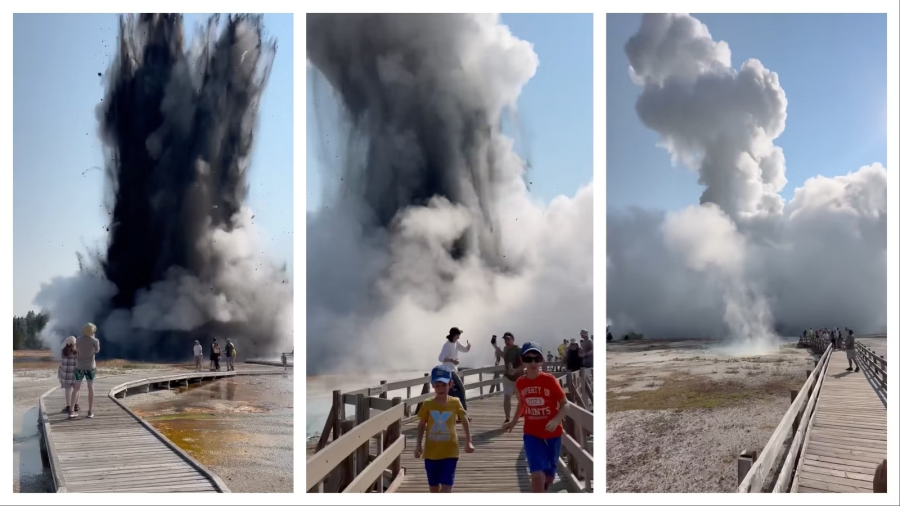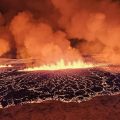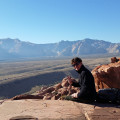
A hydrothermal explosion erupted at Yellowstone National Park’s Biscuit Basin on Tuesday, causing significant damage to a boardwalk and sending park guests scrambling for safety. This unexpected event has raised questions about the potential dangers lurking beneath one of the world’s most famous geothermal areas.
The Incident: What Happened?
The explosion occurred around 10 a.m. local time in the Biscuit Basin thermal area, near the Black Diamond Pool, according to the U.S. Geological Survey (USGS). Fortunately, no injuries were reported. As a precaution, Biscuit Basin, along with its boardwalks and parking lots, have been closed while park geologists investigate the incident. This popular tourist spot lies about two miles northwest of the iconic Old Faithful geyser.
Captured on Video
Video footage shared on social media captured the dramatic moment when the explosion occurred, sending plumes of steam and debris into the air. Vlada March, who posted the video, described the explosion happening right in front of her family. “Boardwalk destroyed, my mom got some of the debris but everyone is safe. Unbelievable and grateful to be alive,” March wrote.
Understanding Hydrothermal Explosions
Hydrothermal explosions happen when superheated water rapidly converts to steam underground, creating a powerful burst. These events are relatively common in Yellowstone, a region known for its geothermal activity. Similar incidents have occurred in the Norris Geyser Basin and Biscuit Basin over the years. USGS has assured that these explosions are not indicators of impending volcanic eruptions and are not caused by magma rising toward the surface.
The Yellowstone Supervolcano: A Looming Threat?
While the recent hydrothermal explosion poses no immediate threat of a volcanic eruption, it draws attention to the broader, more terrifying potential of the Yellowstone supervolcano. This massive volcanic system has the potential to unleash one of the most catastrophic natural disasters in human history.
If the Yellowstone supervolcano were to erupt, the consequences would be devastating. The initial explosion would likely obliterate everything within a 60-mile radius. Ash clouds could spread across the entire United States, affecting air travel, agriculture, and climate. The release of volcanic gases could lead to a “volcanic winter,” drastically lowering global temperatures and disrupting ecosystems worldwide.
Is There a Connection?
Today’s hydrothermal explosion is not directly linked to the supervolcano’s potential eruption. However, it serves as a stark reminder of the volatile and unpredictable nature of Yellowstone’s geothermal landscape. Scientists closely monitor the region for any signs of increased volcanic activity, and while current volcanic activity levels remain normal, the potential for a future eruption cannot be dismissed.
Additional Insights into Yellowstone
Yellowstone National Park, established in 1872, is the first and oldest national park in the world. It sits atop a massive volcanic hotspot that has produced three cataclysmic eruptions in the past 2.1 million years. The most recent eruption, approximately 640,000 years ago, created the Yellowstone Caldera, a 30 by 45-mile depression that continues to fuel the park’s geothermal features.
The park’s geothermal activity includes over 10,000 thermal features, such as geysers, hot springs, mud pots, and fumaroles. Old Faithful, one of the most famous geysers, erupts approximately every 90 minutes, delighting millions of visitors each year.
Conclusion
While hydrothermal explosions like the one at Biscuit Basin are part of Yellowstone’s natural activity, they highlight the ongoing risks associated with the park’s dynamic geology. The potential eruption of the Yellowstone supervolcano remains a distant but formidable threat, one that underscores the importance of vigilant monitoring and research. Visitors to Yellowstone should remain aware of the park’s unpredictable nature and always prioritize safety when exploring its unique and powerful landscapes.
Disclaimer: The information presented in this article is based on the available data and current events around the time of publication, to the best of our staff’s research and knowledge. It is intended for educational and informational purposes only and should not be construed as professional advice, financial advice, sports betting advice, or life advice. It is simply our best guess, something to add to your research. We at Las Vegas Top Picks do our best to get stories accurate, but sometimes mistakes and biases happen, and it is always good to double-check other sources and media outlets to confirm stories and the factual details. The opinions expressed in this article do not necessarily reflect the overall opinion of Las Vegas Top Picks.








